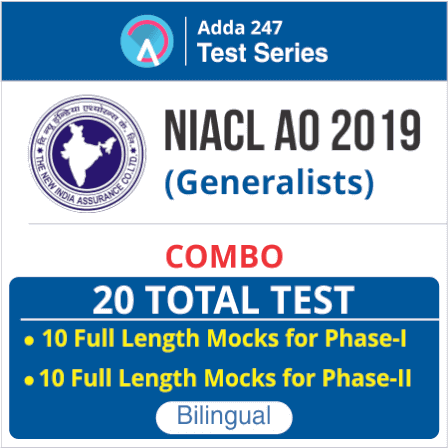Reasoning Questions for NIACL AO 2019
Reasoning Ability is an onerous section. With the increasing complexity of questions, it becomes hard for one to give it the cold shoulder. The only way to make the grade in this particular section in the forthcoming banking exams like NIACL AO Prelims is to practice continuously with all your heart and soul. And, to let you practice with the best of the latest pattern questions, here is the Adda247 Reasoning Quiz based on the exact same pattern of questions that are being asked in the exams.
Directions (1-5): Study the following information to answer the given questions:
Twelve people are sitting in two parallel rows containing six people each in such a way that there is an equal distance between adjacent persons. In row-1, G, O, U, N, K and P are sitting and all of them are facing South. In row-2, Z, Y, H, B, M and R are sitting and all of them are facing North. Therefore, in the given seating arrangement, each member of a row faces another member of the other row. R sits third to the right of B. B faces P and P does not sit at any of the extreme ends of the lines. N sits third to the right of U. H faces K. The one facing K sits third to the right of Z. O and Z does not sit at the extreme ends of the lines. M is not an immediate neighbour of B and P is not an immediate neighbour of N.
Q1. How many persons are seated between M and H?
One
Two
Three
Four
None
Q2. Who among the following represent the persons sitting at extreme ends of the rows?
H, P
M, G
N, H
U, Y
B, G
Q3. Who sits third to the right of G?
U
K
O
N
P
Q4. Which of the following person faces the one who sits diagonally opposite to the one, who sits second to the right of Y?
Z
R
M
K
O
Q5. Four of the following five are alike in a certain way and thus form a group. Which is the one that does not belong to that group?
O, M
G, Y
U,B
P, Z
K, Y
Directions (6-10): Study the following information carefully and answer the given questions:
In a certain code language
‘rabbit is very carrot’ is written as ‘jla jta jja jsa’,
‘love drinks are rabbit’ is written as ‘jja jpa jra jda’
and ‘pigeon is very love’ is written as ‘jda jta jfa jla’.
Q6. What is the code for ‘carrot’?
jsa
jda
jja
jla
None of these
Q7. ‘rabbit love pigeon’ can be coded as
jsa jja jra
jfa jja jda
jda jra jta
Can’t be determined
None of these
Q8. What is the code for ‘drinks’?
jra
jpa
Either jra or jpa
jda
None of these
Q9. Which of the following is the code for ‘pigeon’?
jta
jda
jla
jfa
None of these
Q10. What does ‘jta’ stand for?
rabbit
carrot
pigeon
love
None of these
Directions (11-15): Each of the questions below consists of question and two statements numbered I, and II given below it. You have to decide whether the data provided in the statements are sufficient to answer the question. Read both the statements and give answer.
Q11. On which day of the year did P celebrates his marriage anniversary?
I. P’s sister correctly remembers that his marriage anniversary is before 20th but after 17th of January.
II. P’s brother remembers that his anniversary is after 18th but before 21st of January.
If the data in statement I alone are sufficient to answer the question while the data in statement II are not sufficient to answer the question.
If the data in statement II alone are sufficient to answer the question while the data in statement I are not sufficient to answer the question.
If the data either in statement I alone or in statement II alone are sufficient to answer the question.
If the data even in both statement I and statement II are not sufficient to answer the question.
If the data in both statement I and statement II are sufficient to answer the question.
Solution:
19th January
Q12. Who among P, Q, R, S and T is the heaviest?
I. Weight of Q is 77kg, which is less than the sum of the weights of P and R. Both S and R weighs less than 50kg.
II. P’s weight is more than that of both S and T but less than that of R who is the second heaviest.
If the data in statement I alone are sufficient to answer the question while the data in statement II are not sufficient to answer the question.
If the data in statement II alone are sufficient to answer the question while the data in statement I are not sufficient to answer the question.
If the data either in statement I alone or in statement II alone are sufficient to answer the question.
If the data even in both statement I and statement II are not sufficient to answer the question.
If the data in both statement I and statement II are sufficient to answer the question.
Solution:
From statement II, R>P> (S, T), Since R is the second heaviest, it means Q is the heaviest.
Q13. Among A, B, C, D and E, who is the third highest scorer?
I. C scored more than A and E, but less than B, who is not the top scorer.
II. E scored more than only A.
If the data in statement I alone are sufficient to answer the question while the data in statement II are not sufficient to answer the question.
If the data in statement II alone are sufficient to answer the question while the data in statement I are not sufficient to answer the question.
If the data either in statement I alone or in statement II alone are sufficient to answer the question.
If the data even in both statement I and statement II are not sufficient to answer the question.
If the data in both statement I and statement II are sufficient to answer the question.
Solution:
From I, D>B>C>A, E. Hence C is third highest scorer.
Statements II is not sufficient, some more information are needed.
Q14. Who among the R, O, L, E and S is the shortest?
I. L is taller than O and S but shorter than E.
II. E is not the tallest.
If the data in statement I alone are sufficient to answer the question while the data in statement II are not sufficient to answer the question.
If the data in statement II alone are sufficient to answer the question while the data in statement I are not sufficient to answer the question.
If the data either in statement I alone or in statement II alone are sufficient to answer the question.
If the data even in both statement I and statement II are not sufficient to answer the question.
If the data in both statement I and statement II are sufficient to answer the question.
Solution:
From I, E>L>O and S
From II, At least one person is taller than E.
So, data insufficient
Q15. What is P’s rank in a class of 40?
I. A, who is 4th from the top in the class, is above K by 24 ranks. K is the below from P by 7 ranks.
II. M, whose rank is between P and Z, is 30th from the bottom. A scored more than P.
If the data in statement I alone are sufficient to answer the question while the data in statement II are not sufficient to answer the question.
If the data in statement II alone are sufficient to answer the question while the data in statement I are not sufficient to answer the question.
If the data either in statement I alone or in statement II alone are sufficient to answer the question.
If the data even in both statement I and statement II are not sufficient to answer the question.
If the data in both statement I and statement II are sufficient to answer the question.
Solution:
From I,
A’s rank= 4th from top
K’s rank= 28th from top
P’s rank= 21st from top.




 Reasoning Quiz For Bank Foundation 2024 ...
Reasoning Quiz For Bank Foundation 2024 ...
 Reasoning Quiz For Bank Foundation 2024 ...
Reasoning Quiz For Bank Foundation 2024 ...



